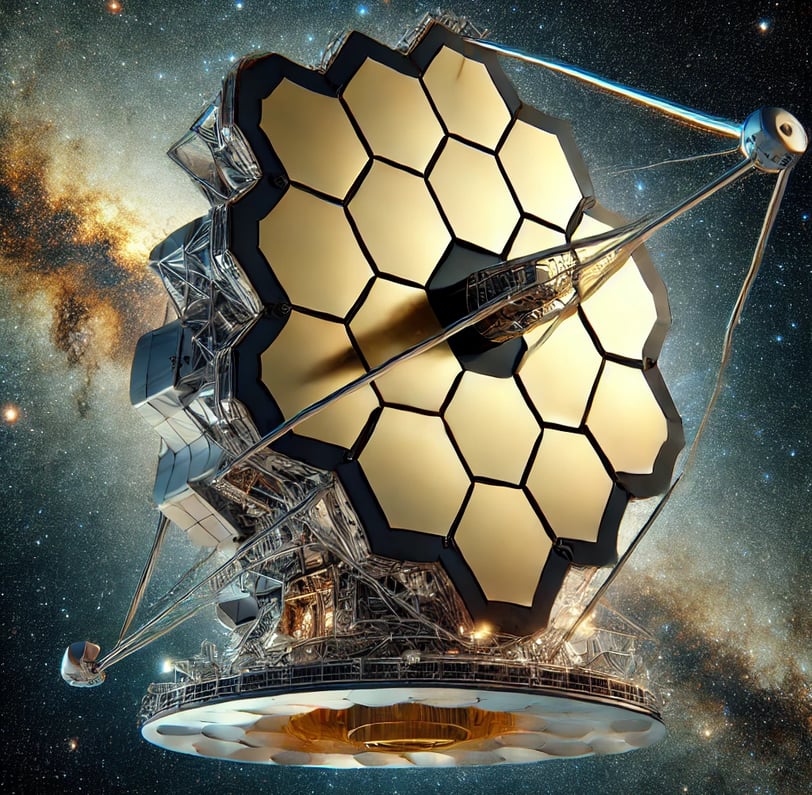James Webb Space Telescope: The New Frontier of Astronomy
The James Webb Space Telescope (JWST) is the most advanced space observatory ever built. Developed by NASA in collaboration with the European Space Agency (ESA) and the Canadian Space Agency (CSA), it was designed to expand our knowledge of the universe, surpassing the capabilities of the iconic Hubble Space Telescope.
3/7/20253 min read


Development and Challenges
The development of JWST began in the 1990s, with an initial launch date planned for 2007. However, technical challenges, design revisions, and budgetary difficulties led to multiple delays. The project faced issues such as overheating, adjustments to the thermal shield and mirror articulations, as well as rigorous testing to ensure it could withstand the harsh conditions of space.
The construction involved various companies and institutions, including Northrop Grumman, which led the integration of the components. The telescope required more than 20 years of development and an investment of approximately 10 billion dollars.
Launch and Journey to Space
The launch took place on December 25, 2021, aboard the Ariane 5 rocket from the Kourou Space Center in French Guiana. The rocket carried JWST in a folded configuration due to its immense size and placed it on a trajectory toward the Lagrange Point L2. During its approximately one-month journey, the telescope underwent a complex unfolding process, including the deployment of its five-layer thermal shield and the precise alignment of its 18-segment primary mirror.
Features and Advanced Technologies
JWST is an infrared telescope with a segmented 6.5-meter primary mirror composed of 18 hexagonal segments coated with gold.
Technologies Used:
Segmented Primary Mirror: Made of beryllium coated with gold to efficiently reflect infrared light.
Five-Layer Thermal Shield: The size of a tennis court, it protects the instruments from the Sun's heat.
Precision Alignment Sensors: Maintain stability to capture sharp images.
Advanced Scientific Instruments:
NIRCam (Near Infrared Camera): The primary camera that captures images in the near-infrared spectrum.
NIRSpec (Near Infrared Spectrograph): A spectrometer that analyzes the chemical composition of distant objects.
MIRI (Mid-Infrared Instrument): Operates in the mid-infrared range, allowing observations of exoplanets and distant galaxies.
FGS/NIRISS (Fine Guidance Sensor/Near InfraRed Imager and Slitless Spectrograph): Assists in stabilizing the telescope and conducting detailed spectroscopy.
Scientific Objectives
JWST was designed to investigate some of the most fundamental questions in astronomy, including:
Formation of the first galaxies: Studying objects formed in the first billion years of the universe.
Evolution of galaxies: Observing how galaxies have transformed over time.
Lifecycle of stars: Examining how stars are born, evolve, and die.
Formation of planetary systems: Studying exoplanets and their atmospheres to understand the possibility of life beyond Earth.
Location and Operability
Unlike Hubble, which orbits Earth, JWST is located at Lagrange Point L2, about 1.5 million kilometers from our planet. This position provides an unobstructed view of the universe, free from interference from Earth and the Sun. The telescope uses a large five-layer thermal shield to protect itself from solar heat and maintain its instruments at extremely low temperatures, necessary for infrared observations.
Discoveries and Scientific Impact
Since its operational start in 2022, JWST has already provided groundbreaking images and data, revealing:
Structures of primordial galaxies: Highly detailed images of galaxies formed just a few billion years after the Big Bang.
Exoplanets and their atmospheres: Detection of molecules such as water, methane, and carbon dioxide in the atmospheres of planets outside the Solar System.
Nebulae and star-forming regions: Detailed observations of stellar nurseries such as the Carina Nebula.
Supermassive black holes: Studies on interactions between black holes and their host galaxies.
Accidents and Setbacks
Although JWST was successfully deployed and operated, it has suffered minor micrometeoroid impacts, including a significant event in May 2022 that affected one of the mirror segments. Fortunately, adjustments were made to minimize the damage.
Conclusion
The James Webb Space Telescope represents a significant leap in cosmic exploration. With its ability to see farther and with greater precision than any previous telescope, it is helping scientists unravel the mysteries of the universe and expand our understanding of its origin and evolution. Its impact on astronomy is already immeasurable, and the discoveries yet to come will undoubtedly change our perception of the universe forever.
Explore
Discover diverse topics in one convenient hub.
Connect
Learn
contact@mindstormblog.com
© 2025. All rights reserved.


